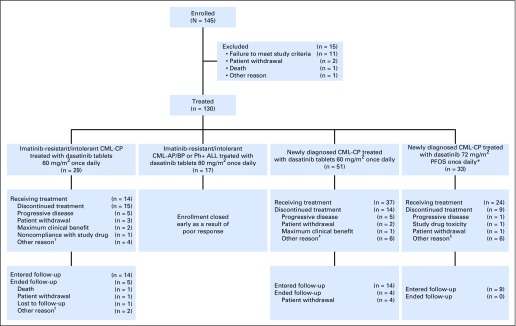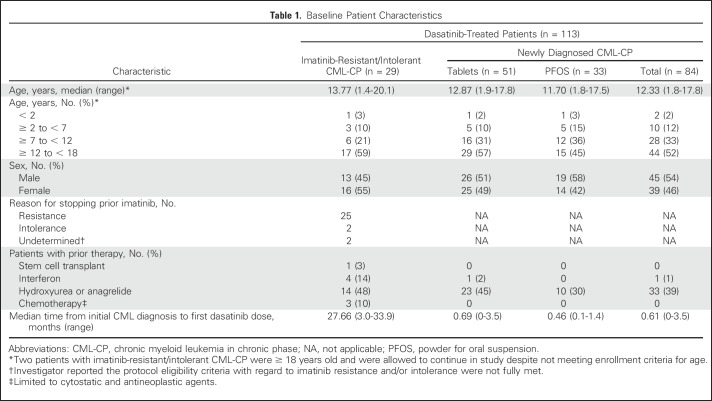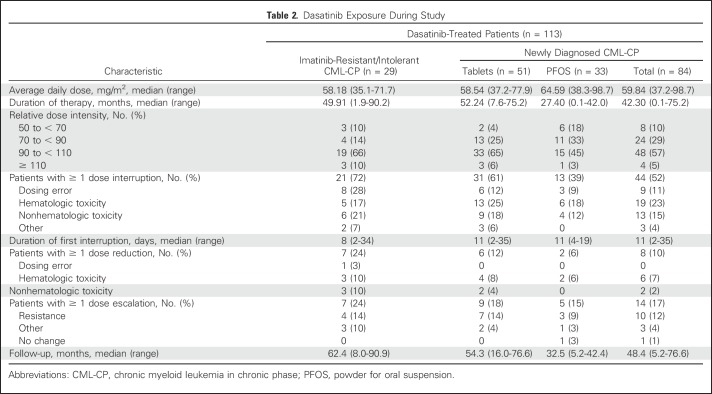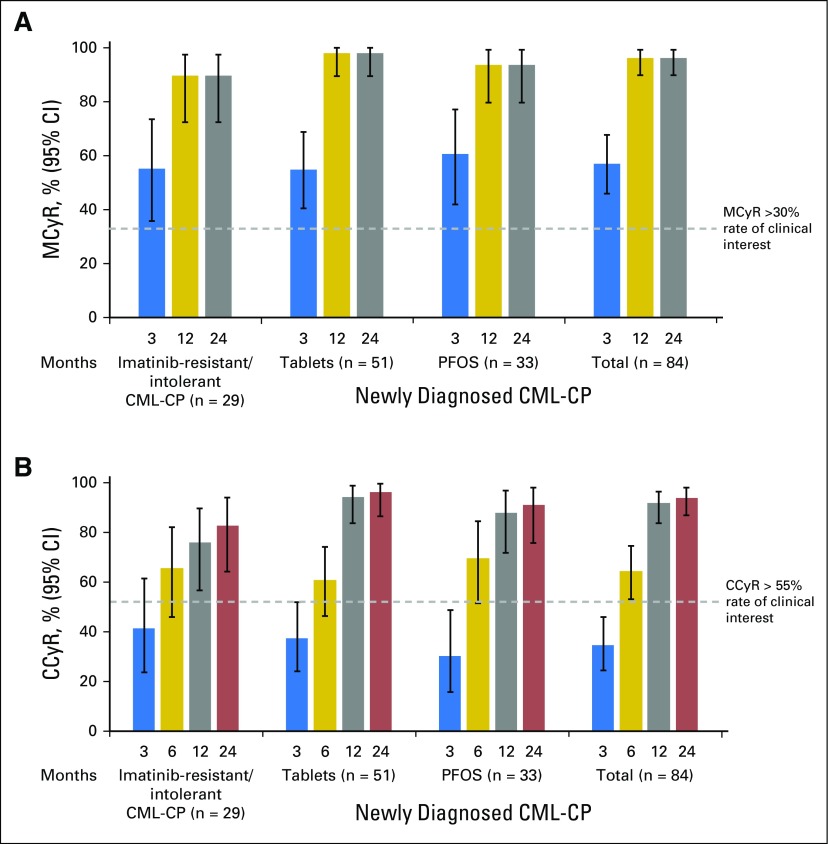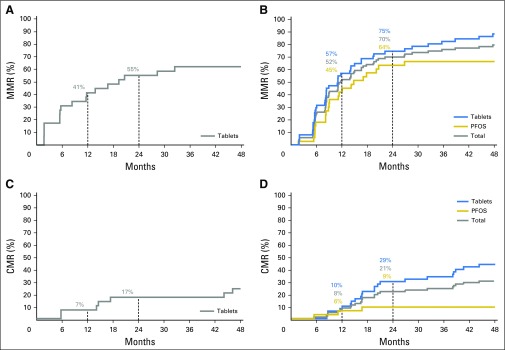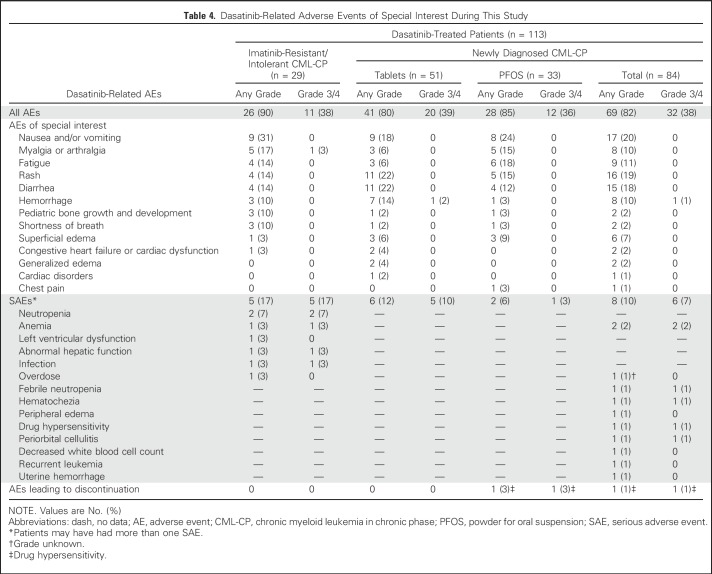Abstract
Purpose
Safe, effective treatments are needed for pediatric patients with chronic myeloid leukemia in chronic phase (CML-CP). Dasatinib is approved for treatment of adults and children with CML-CP. A phase I study determined suitable dosing for children with Philadelphia chromosome–positive (Ph+) leukemias.
Methods
CA180-226/NCT00777036 is a phase II, open-label, nonrandomized prospective trial of patients < 18 years of age receiving dasatinib. There are three cohorts: (1) imatinib-resistant/intolerant CML-CP, (2) imatinib-resistant/intolerant CML in accelerated/blast phase or Ph+ acute lymphoblastic leukemia (n = 17), and (3) newly diagnosed CML-CP treated with tablets or powder for oral suspension. Major cytogenetic response > 30% for imatinib-resistant/intolerant patients and complete cytogenetic response (CCyR) > 55% for newly diagnosed patients were of clinical interest.
Results
Of 113 patients with CML-CP, 14 (48%) who were imatinib-resistant/intolerant and 61 (73%) who were newly diagnosed remained on treatment at time of analysis. Major cytogenetic response > 30% was reached by 3 months in the imatinib-resistant/intolerant group and CCyR > 55% was reached by 6 months in the newly diagnosed CML-CP group. CCyR and major molecular response by 12 months, respectively, were 76% and 41% in the imatinib-resistant/intolerant group and 92% and 52% in newly diagnosed CML-CP group. Progression-free survival by 48 months was 78% and 93% in the imatinib-resistant/intolerant and newly diagnosed CML-CP groups, respectively. No dasatinib-related pleural or pericardial effusion, pulmonary edema, or pulmonary arterial hypertension were reported. Bone growth and development events were reported in 4% of patients.
Conclusion
In the largest prospective trial to date in children with CML-CP, we demonstrate that dasatinib is a safe, effective treatment of pediatric CML-CP. Target responses to first- or second-line dasatinib were met early, and deep molecular responses were observed. Safety of dasatinib in pediatric patients was similar to that observed in adults; however, no cases of pleural or pericardial effusion or pulmonary arterial hypertension were reported.
INTRODUCTION
Although chronic myeloid leukemia (CML) accounts for < 5% of leukemias and < 1% of all cancers in patients < 20 years of age,1 more aggressive disease characteristics have been observed in pediatric and young adult patients with CML compared with older adults, including higher median white blood cell counts, proportionally larger spleen size, higher peripheral blasts counts, and lower hemoglobin levels.2 However, there are conflicting reports about the prognostic relevance of these variables on outcomes in children.3-5
The development of safe and effective therapies for pediatric CML is critical for the successful treatment of this patient population. Until recently, the BCR-ABL1–target tyrosine kinase inhibitor (TKI) imatinib was the only TKI approved for front-line treatment of pediatric patients with CML in chronic phase (CML-CP)6; however, 25% to 29% discontinue as a result of poor response or toxicity.7,8 In addition, there were no approved therapies to treat children with imatinib-resistant/intolerant CML-CP. There is also a need for formulations of TKIs for younger patients who are unable to swallow tablets.9
Dasatinib is a second-generation TKI that is now approved in tablet formulation for the treatment of pediatric patients with CML-CP.10 Previously, dosing and safety of dasatinib in pediatric patients were determined in phase I trials.11,12 Here, we present results from a phase II prospective trial to further evaluate safety and efficacy of dasatinib tablet and powder for oral suspension (PFOS) formulations in pediatric patients with CML-CP.
METHODS
Study Design
Study CA180-226 is an ongoing phase II, open-label, nonrandomized, multicenter trial investigating dasatinib in pediatric patients with Philadelphia chromosome–positive (Ph+) leukemia (ClinicalTrials.gov identifier: NCT00777036). Patients < 18 years of age (the protocol was amended 9 months after enrollment started to change inclusion criteria from < 21 to < 18 years) were enrolled in three cohorts (Fig 1): (1) patients with CML-CP resistant to or intolerant of imatinib who received dasatinib tablets 60 mg/m2 once daily; (2) patients with accelerated- or blastic-phase CML (CML-AP/BP) or Ph+ acute lymphoblastic leukemia (ALL) resistant to or intolerant of imatinib who received dasatinib tablets 80 mg/m2 once daily; and (3) patients with CML-CP newly diagnosed who received either dasatinib tablets 60 mg/m2 once daily or PFOS 72 mg/m2 once daily for ≥ 12 months; patients were then allowed to switch to tablets. PFOS dose was increased by 20% (to 72 mg/m2) to match the exposure of the 60 mg/m2 tablet on the basis of bioavailability data in adults. Detailed inclusion and exclusion criteria are listed in the Data Supplement.
Fig 1.
CONSORT diagram of study CA180-226. (*)Patients had the option to switch to dasatinib tablets 60 mg/m2 once daily after 1 year of receiving PFOS. (†)Other includes bone marrow transplant, allogenic bone marrow graft, suboptimal response, and patient lost to follow-up. (‡)Other includes T315I mutation, loss of major molecular response, investigator decision, loss of complete cytogenetic response (n = 2), and hematopoietic stem cell transplant (n = 2). (§)Other includes hematopoietic stem cell transplant (n = 2), suboptimal response, second malignancy, and transition to adult hospital (n = 2). (ǁ)Other includes transfer to adult hospital and bone marrow transplant. CML-AP/BP, chronic myeloid leukemia in accelerated/blast phase; CML-CP, chronic myeloid leukemia in chronic phase; PFOS, powder for oral suspension; Ph+ ALL, Philadelphia chromosome-positive acute lymphoblastic leukemia.
Patients could receive dasatinib until disease progression, unacceptable toxicity, or patient/physician preference. Patients who discontinued therapy were followed yearly for survival, effects on growth and development, and effects on bone metabolism up to 5 years after the last dasatinib dose. The protocol was approved by all institutional review boards, ethics committees, and national competent authorities at participating sites. All patients and/or legal guardians gave written informed consent and assent where applicable in accordance with the Declaration of Helsinki and local guidelines.
Evaluations
Primary objectives were to determine major cytogenetic response (MCyR) for patients with imatinib-resistant/intolerant CML-CP, complete hematologic response (CHR) for patients with imatinib-resistant/intolerant CML-AP/BP or Ph+ ALL, and complete cytogenetic response (CCyR) for patients with newly diagnosed CML-CP at any time. MCyR > 30% for imatinib-resistant/intolerant CML-CP, CHR > 15% for imatinib-resistant/intolerant CML-AP/BP or Ph+ ALL, and CCyR > 55% for newly diagnosed CML-CP were considered of clinical interest and align with historic responses in pediatric patients with CML-CP.7,8 Secondary objectives included assessments of safety and evaluation of best cytogenetic and hematologic response, time to and duration of response, disease-free survival, progression-free survival (PFS), overall survival (OS), complete molecular response (CMR), and major molecular response (MMR). The description of BCR-ABL1 mutations at baseline (results of which were not available before start of study treatment), progression, treatment failure, or end of treatment, and the exploration of the role of mutations as predictors of response were also secondary objectives. The database lock for this analysis was November 2016. Detailed definitions of efficacy outcomes, safety assessments, mutational analysis, and statistical methodology can be found in the Data Supplement.
RESULTS
Patients and Treatments
In total, 145 patients were enrolled between March 2009 and September 2014. Of these, 130 were treated across three cohorts (Fig 1): 29 with imatinib-resistant/intolerant CML-CP, 17 with imatinib-resistant/intolerant CML-AP/BP or Ph+ ALL, and 84 with newly diagnosed CML-CP. Newly diagnosed patients were either treated with dasatinib tablets (n = 51) or PFOS for ≥ 12 months (n = 33). Given the observed poor response of patients with imatinib-resistant/intolerant CML-AP/BP or Ph+ ALL (CHR was achieved at any time by one of eight patients with CML-BP and four of nine patients with Ph+ ALL), and that single-agent TKIs are now considered substandard of care for this pediatric population, this cohort was closed after 17 patients were enrolled. Discussion of these data are not included in this report.
Baseline characteristics for the cohorts of CML-CP are in Table 1. With ≥ 24 months of follow-up, 14 patients (48%) with CML-CP resistant to or intolerant of imatinib and 61 patients (73%) with newly diagnosed CML-CP were still receiving study treatment. Reasons for exclusion and discontinuation are listed in Fig 1. Most patients received the protocol-recommended daily dose of dasatinib (Table 2). Patients who were initiated on PFOS were allowed to switch to tablets after receiving PFOS for ≥ 1 year. Of the 33 patients receiving PFOS, 22 (67%) switched to tablets because of patient preference. Greater than 38% of patients required at least one dose interruption, primarily because of dosing errors and hematologic toxicity (Table 2). Less than 25% of patients required dose reductions or escalations.
Table 1.
Baseline Patient Characteristics
Table 2.
Dasatinib Exposure During Study
Efficacy
Rates of confirmed CHR (cCHR) achieved at any time on treatment were 93% (95% CI, 77.2 to 99.2) and 96% (95% CI, 89.9 to 99.3) for patients resistant to or intolerant of imatinib or those newly diagnosed, respectively. Median time to cCHR was 0.7 months (95% CI, 0.5 to 1.8) for patients resistant to or intolerant of imatinib and 1.2 months (95% CI, 0.9 to 1.4) for newly diagnosed patients.
The cumulative rate of MCyR > 30% was reached as early as 3 months for patients with imatinib-resistant/intolerant CML-CP, and the cumulative rate of CCyR > 55% was reached as early as 6 months for patients with newly diagnosed CML-CP (Fig 2). Rapid responses were illustrated by a median time to MCyR of 3.1 months (95% CI, 2.8 to 4.1) for those in the imatinib-resistant/intolerant group and 3.0 months (95% CI, 2.9 to 4.3) for newly diagnosed patients, and a median time to CCyR of 3.9 months (95% CI, 2.8 to 5.6) for patients in the resistant/intolerant CML-CP group and 5.6 months (95% CI, 5.0 to 6.0) for newly diagnosed patients (Table 3). Cumulative cytogenetic response rates increased over time through 24 months, the minimum follow-up for this analysis (Fig 2). In both cohorts, rates of MCyR increased between 3 and 12 months and were maintained through 24 months. For patients with CML-CP resistant to or intolerant of imatinib, rates of CCyR consistently increased. Median durations of cytogenetic responses were not reached by the time of analysis (Table 3).
Fig 2.
Cytogenetic responses over time for all treated patients. (A) Cumulative rates of MCyR and (B) cumulative rates of CCyR. CCyR, complete cytogenetic response; CML-CP, chronic myeloid leukemia in chronic phase; MCyR, major cytogenetic response; PFOS, powder for oral suspension.
Table 3.
Time To and Duration of Response in Patients Treated With Dasatinib
Additional assessments were performed to determine the rates of cytogenetic responses at any time, excluding patients with MCyR/CCyR or unknown cytogenetic status at baseline. The results from these assessments were similar to the results calculated using the total number of patients in each cohort (Data Supplement).
Although they were not focal study end points, the cumulative rates of MMR and CMR were also observed to increase over time in all cohorts (Fig 3). By 12 months, MMR was 41% and CMR was 7% for patients with imatinib-resistant/intolerant CML-CP, and by 24 months, MMR was 55% and CMR was 17% (Figs 3A and 3C). MMR and CMR were 52% and 8%, respectively, by 12 months and 70% and 21%, respectively, by 24 months for the total newly diagnosed patient population (Figs 3B and 3D). Cohorts in this study were not designed to be comparative; however, response rates appeared to be lower for patients taking the PFOS formulation versus tablets. Median time to MMR was 8.9 months (95% CI, 8.1 to 11.7) for newly diagnosed patients and was not calculated for the imatinib-resistant/intolerant cohort.
Fig 3.
Cumulative rates of molecular responses over time for all treated patients. (A, B) MMR for (A) patients with CML-CP resistant to or intolerant of imatinib and (B) patients with newly diagnosed CML-CP. (C, D) CMR for (C) patients with CML-CP resistant to or intolerant of imatinib and (D) patients with newly diagnosed CML-CP. Cohorts were not designed to be comparative. There are numerical differences between MMR and CMR in newly diagnosed patients with CML-CP treated with dasatinib tablets or PFOS, but CIs overlap. CML-CP, chronic myeloid leukemia in chronic phase; CMR, complete molecular response; MMR, major molecular response; PFOS, powder for oral suspension.
Median PFS and OS have not been reached in any cohort. Disease is seven of 29 patients (24%) resistant to or intolerant of imatinib and seven of 84 newly diagnosed patients (8%) had progressed at the time of analyses (Data Supplement). Protocol-defined reasons for progression were loss of MCyR (n = 3 in the imatinib-resistant/intolerant group; n = 4 newly diagnosed patients), loss of CHR (n = 2 in each group), and development of CML-BP (n = 2 in the imatinib-resistant/intolerant group; n = 1 in the newly diagnosed group). Estimated 48-month PFS was 78% and 93% for patients with CML-CP resistant to or intolerant of imatinib and patients with newly diagnosed CML-CP, respectively (Data Supplement). Similar results were observed for disease-free survival (Data Supplement). One death was reported: a patient with CML-CP resistant to or intolerant of imatinib died of gastrointestinal bleeding 1 year after stopping dasatinib. This patient had loss of MCyR before death. There were no deaths reported for patients with newly diagnosed CML-CP. The estimated 48-month OS rate was 96% in the imatinib-resistant/intolerant CML-CP cohort.
A post hoc analysis of the proportion of patients with BCR-ABL1 ≤ 10% versus > 10% at 3 months was performed for the newly diagnosed cohort. Of the 77 patients with evaluable transcript levels at 3 months, 60 (78%) had BCR-ABL1 ≤ 10% and 17 (22%) had BCR-ABL1 > 10%. PFS appeared to be higher for newly diagnosed patients with BCR-ABL1 ≤ 10% versus those with BCR-ABL1 > 10% at 3 months (P < .001; hazard ratio, 0.10; 95% CI, 0.02 to 0.52); estimated 3-year PFS rates were approximately 97% and 82% for patients with BCR-ABL1 ≤ 10% or > 10% at 3 months, respectively.
BCR-ABL1 mutations were assessed at baseline and at the time of disease progression, treatment failure, or end of treatment. In the imatinib-resistant/intolerant cohort, six of 27 patients (22%) evaluated at baseline had a mutation (E255K, F317L, F359V [n = 2], V379I, Y253H); five were in cCHR. Of nine patients with assessments at end of treatment, three had a mutation (E255K, F317L, T315A). The patients with the E255K and F317L mutations had the same mutation at baseline and end of treatment. No patient in this cohort had more than one mutation. Mutations in BCR-ABL1 at T315, F317, and V299 are now considered resistant to dasatinib,13 which was not fully understood when this trial began. Of the 78 patients with newly diagnosed CML-CP evaluated at baseline, one had a P58S mutation that was found in leukemia cells only. This patient was receiving dasatinib tablets and had cCHR. There were no mutations detected in the seven patients newly diagnosed with CML-CP who were evaluated at end of treatment.
Safety
The dasatinib-related adverse events (AEs) of special interest reported in this study are listed in Table 4. There were no occurrences of pleural effusion, pericardial effusion, pulmonary edema, pulmonary hypertension, or pulmonary arterial hypertension related to dasatinib in pediatric patients with CML-CP. In patients with imatinib-resistant/intolerant CML-CP and newly diagnosed patients, any-grade myalgia or arthralgia occurred in 17% and 10%, respectively, and fatigue occurred in 14% and 11%, respectively. Dasatinib-related pediatric bone growth and development AEs were grouped together for reporting purposes. Grade 1/2 events were reported in five of 113 patients (4%) with CML-CP. Data on growth and development continue to be collected and will be reported once mature.
Table 4.
Dasatinib-Related Adverse Events of Special Interest During This Study
Dasatinib-related serious AEs were reported in five patients (17%) with imatinib-resistant/intolerant CML-CP and eight patients (10%) with newly diagnosed CML-CP (Table 4). No suspected, unexpected serious adverse reactions were reported. There was one dasatinib-related AE leading to discontinuation (grade 3 drug hypersensitivity, which resolved when the drug was discontinued). Safety assessment of the 17 pediatric patients with CML-AP/BP or Ph+ ALL was consistent with the known safety profile in adults with advanced Ph+ leukemias.14-16
DISCUSSION
CA180-226 is the largest prospective, registrational trial to date in pediatric patients diagnosed with CML. With ≥ 24 months of follow-up, high response rates and a favorable safety profile for dasatinib were demonstrated in patient with imatinib-resistant/intolerant CML-CP and those newly diagnosed with CML-CP.
This study was designed to explore the most clinically relevant end points for patients with CML at the time the protocol was developed in 2008: MCyR and CCyR. Overall, the efficacy of dasatinib in pediatric patients in this trial was similar to or higher than that historically observed in adults. In a phase III dose-optimization trial of adults with imatinib-resistant/intolerant CML-CP, 2-year MCyR was 63%17; in pediatric patients treated in this study, the MCyR rate by 2 years was 90%. Estimated PFS rates at 2 years were similar in adults and pediatric patients with CML-CP resistant to or intolerant of imatinib (80% and 82%, respectively). In adults with newly diagnosed CML-CP from the phase III Dasatinib Versus Imatinib Study in Treatment-Naïve Chronic Myeloid Leukemia Patients (DASISION), the cumulative CCyR rate by 2 years was 86%18; the rate in newly diagnosed pediatric patients treated in the present study was 94%. Estimated 2-year PFS rates were similar in newly diagnosed adults and pediatric patients (94% and 95%, respectively).
The results described here in patients treated with first-line dasatinib are promising compared with results previously reported in pediatric patients treated with first-line imatinib. The French National Phase IV Trial (n = 44), a prospective study of newly diagnosed pediatric patients with CML-CP treated with imatinib 260 mg/m2 daily, reported CCyR and MMR rates at 12 months of 61% and 31%, respectively.7 In a study of patients < 18 years of age and treated with high-dose imatinib (340 mg/m2 daily), 51% achieved CCyR and 30% achieved MMR at 12 months.8 CCyR by 12 months was reported to be 72% in newly diagnosed patients < 22 years of age receiving imatinib 340 mg/m2 daily.19 Newly diagnosed pediatric patients treated with dasatinib in this study had CCyR and MMR rates by 12 months of 92% and 52%, respectively. MMR is currently considered a more relevant objective of CML therapy, and findings in this trial support that deep and durable molecular remissions are achievable at high levels in pediatric patients with CML-CP treated with dasatinib.
Achieving early molecular response (EMR) has been associated with improved long-term outcomes in adults and pediatric patients with CML treated with TKIs.5,20 For newly diagnosed pediatric patients treated with dasatinib in this study, 78% achieved BCR-ABL1 ≤ 10% at 3 months. In the French National Phase IV Trial, 63% achieved this same milestone with imatinib.21 This comparison is consistent with results observed in newly diagnosed adults treated with dasatinib versus imatinib (84% v 64%, respectively).22 Such observed differences between dasatinib and imatinib may be relevant given the emerging evidence that early, deep response is of clinical relevance in CML. In newly diagnosed patient populations treated with dasatinib or imatinib, a significant association between EMR and PFS was observed.21,22 In contrast, EMR was not correlated with improved outcomes in pediatric patients treated with high-dose imatinib.23
In adults, more patients receiving dasatinib achieved EMR than those receiving imatinib; EMR has been shown to predict improved long-term survival outcomes and deep molecular responses, currently a requirement for consideration in TKI discontinuation and discontinuation trials.20 Our data suggest a possible role for front-line dasatinib in achieving earlier and deeper responses in pediatric patients, although long-term studies would be needed to prove superiority in survival. Permanent discontinuation of TKIs is a key unmet, and currently unstudied, need in the treatment of pediatric CML. Efficacy of dasatinib in patients with imatinib-resistant/intolerant CML-CP in our study is of particular interest because all but two patients were resistant to imatinib. Long-term data from this trial and others, as well as randomized trials, are needed to confirm the best front-line TKI for pediatric patients.
TKI cost should also be considered when choosing a front-line TKI. With the introduction of generic imatinib in the United States, imatinib is expected to have a lower initial cost than dasatinib.24 However, the total cost of dasatinib versus imatinib over a patient’s life may be less. Our data and data from other reports suggest that patients receiving dasatinib are more likely to achieve early and deep responses and may be eligible for TKI discontinuation.20 Additionally, nonadherence is associated with increased health care costs,25 and complex treatment regimens have been shown to decrease adherence.26
Dasatinib has been shown to be better tolerated than imatinib in adults with CML-CP,22 and there is some evidence, including results described here, that suggest better tolerability of dasatinib versus imatinib in children.7 There were no reported pleural effusion or pulmonary hypertension events in pediatric patients from this trial or from the phase I study.12 In contrast, dasatinib-related pleural effusion was reported in 28% of adults with newly diagnosed and imatinib-resistant/intolerant CML-CP, and dasatinib-related pulmonary hypertension was reported in 5% of newly diagnosed adults and 2% adults with imatinib-resistant/intolerant CML-CP.22,27 It is possible that the pediatric patients in this study had fewer or no cardiopulmonary comorbidities that would predispose them to the events seen in adults. It is also important to investigate potential effects of dasatinib on growth and development in pediatric patients. Follow-up is ongoing to characterize the safety of chronic dasatinib use, because pediatric patients may live for many decades with CML. This will include assessment of growth and puberty, once the data are more mature. Long-term follow-up is essential, considering late toxicities of TKIs have been observed in case reports.2,5,28
A bioequivalence study conducted in adults demonstrated that the bioavailability of dasatinib PFOS was 19% lower than that of dasatinib tablets,29 which led to the use of 72 mg/m2 dasatinib PFOS in this study. Results reported here were similar between tablets and PFOS; however, this trial was not designed to compare cohorts. A population pharmacokinetic analysis is ongoing to evaluate dasatinib PFOS exposure in pediatric patients. Dasatinib was shown to be safe and well tolerated in pediatric patients at doses up to 120 mg/m2, with no maximum tolerated dose identified in a phase I study.12
This trial was not designed to compare results between cohorts, dasatinib treatment in children versus adults, or dasatinib versus imatinib in pediatric patients. Similarities and differences described here were based on data from separate trials with differences in methodology, patient population, and geographic distribution, which limit interpretation.
Overall, dasatinib treatment produced early, deep, and durable responses of clinical importance in this largest prospective trial of pediatric patients with CML-CP to date. Target responses were met as early as 3 and 6 months for patients with imatinib-resistant/intolerant CML-CP or newly diagnosed CML-CP, respectively. Safety of dasatinib was consistent with that reported in adults, except that no cases of pleural or pericardial effusion or pulmonary arterial hypertension were observed in pediatric patients. These results support dasatinib as a safe and effective first- or second-line option for the treatment of pediatric CML-CP.
ACKNOWLEDGMENT
We thank the patients who participated in this study and the clinical study teams. We thank Dr. Yousif Matloub for his work developing this study and Eric Bleickardt for clinical development contributions to this study. Medical writing and editorial support were provided by Samantha L. Dwyer and Andrea Lockett of StemScientific, an Ashfield Company (Lyndhurst, NJ), and were funded by Bristol-Myers Squibb.
Footnotes
Supported by Bristol-Myers Squibb.
Presented in part at the ASCO Annual Meeting, Chicago, IL, June 2-6, 2017; and the European Hematology Association 22nd Congress, Madrid, Spain, June 22-25, 2017.
AUTHOR CONTRIBUTIONS
Conception and design: Lia Gore, Pamela R. Kearns
Provision of study materials or patients: Lia Gore, C. Michel Zwaan
Collection and assembly of data: Lia Gore, Carmino Antonio De Souza, Yves Bertrand, Nobuko Hijiya, Linda C. Stork, Nack-Gyun Chung, Rocio Cardenas Cardos, Franca Fagioli, Jong Jin Seo, Judith Landman-Parker, Andrew E. Place, C. Michel Zwaan
Data analysis and interpretation: Lia Gore, Maria Lucia de Martino Lee, Nobuko Hijiya, Tapan Saikia, Donna Lancaster, Andrew E. Place, Karen R. Rabin, Mariana Sacchi, Rene Swanink, C. Michel Zwaan
Manuscript writing: All authors
Final approval of manuscript: All authors
Accountable for all aspects of the work: All authors
AUTHORS' DISCLOSURES OF POTENTIAL CONFLICTS OF INTEREST
Dasatinib in Pediatric Patients With Chronic Myeloid Leukemia in Chronic Phase: Results From a Phase II Trial
The following represents disclosure information provided by authors of this manuscript. All relationships are considered compensated. Relationships are self-held unless noted. I = Immediate Family Member, Inst = My Institution. Relationships may not relate to the subject matter of this manuscript. For more information about ASCO's conflict of interest policy, please refer to www.asco.org/rwc or ascopubs.org/jco/site/ifc.
Lia Gore
Stock or Other Ownership: ARIAD (I), Amgen, Sanofi, Celgene, Clovis Oncology, Ignyta (I)
Honoraria: Amgen, Novartis, Bristol-Myers Squibb
Consulting or Advisory Role: Celgene, Novartis, ProEd Communications, Roche, Amgen, Medscape
Patents, Royalties, Other Intellectual Property: Patent held for diagnostic discovery and treatment response methodology tools in the use of MR spectroscopy for leukemia.
Travel, Accommodations, Expenses: Amgen, Roche, Novartis, Bristol-Myers Squibb
Pamela R. Kearns
Honoraria: Celgene
Consulting or Advisory Role: Bristol-Myers Squibb, Genzyme
Research Funding: Pfizer (Inst)
Maria Lucia de Martino Lee
Honoraria: Shire Farmaceutica Brasil, Zodiac Pharma
Consulting or Advisory Role: Shire Farmaceutica Brasil, Zodiac Pharma
Speakers' Bureau: Shire Farmaceutica Brasil, Zodiac Pharma
Travel, Accommodations, Expenses: Amgen Brasil, Shire Farmaceutica Brasil
Carmino Antonio De Souza
No relationship to disclose
Yves Bertrand
Consulting or Advisory Role: Jazz Pharmaceuticals
Nobuko Hijiya
Honoraria: Novartis, Amgen
Consulting or Advisory Role: Novartis, Amgen
Travel, Accommodations, Expenses: Amgen, Kite Pharma
Linda C. Stork
Research Funding: Bristol-Myers Squibb
Nack-Gyun Chung
No relationship to disclose
Rocio Cardenas Cardos
No relationship to disclose
Tapan Saikia
Consulting or Advisory Role: Dr. Reddy's laboratory
Franca Fagioli
No relationship to disclose
Jong Jin Seo
Research Funding: Bristol-Myers Squibb
Judith Landman-Parker
Research Funding: Boehringer Ingelheim (Inst), Bristol-Myers Squibb (Inst), Novartis (Inst), Takeda (Inst)
Donna Lancaster
No relationship to disclose
Andrew E. Place
Consulting or Advisory Role: Abbvie
Research Funding: Karyopharm Therapeutics
Travel, Accommodations, Expenses: Abbvie
Karen R. Rabin
Consulting or Advisory Role: Adaptive Biotechnologies Corporation
Travel, Accommodations, Expenses: Adaptive Biotechnologies Corporation
Mariana Sacchi
Employment: Bristol-Myers Squibb
Rene Swanink
Employment: Bristol-Myers Squibb
Stock or Other Ownership: Bristol-Myers Squibb
Honoraria: Bristol-Myers Squibb
C. Michel Zwaan
Honoraria: Novartis
Consulting or Advisory Role: Celgene (Inst)
Speakers' Bureau: Novartis
Research Funding: Pfizer (Inst), Jazz Pharmaceuticals (Inst), Sanofi (Inst), Bristol-Myers Squibb (Inst)
Travel, Accommodations, Expenses: Jazz Pharmaceuticals
REFERENCES
- 1.Howlader N, Noone AM, Krapcho M, et al. (eds): Previous version: SEER Cancer Statistics Review, 1975-2013. http://seer.cancer.gov/csr/1975_2013/
- 2.Hijiya N, Millot F, Suttorp M: Chronic myeloid leukemia in children: Clinical findings, management, and unanswered questions. Pediatr Clin North Am 62:107-119, 2015 [DOI] [PubMed] [Google Scholar]
- 3.Pemmaraju N, Kantarjian H, Shan J, et al. : Analysis of outcomes in adolescents and young adults with chronic myelogenous leukemia treated with upfront tyrosine kinase inhibitor therapy. Haematologica 97:1029-1035, 2012 [DOI] [PMC free article] [PubMed] [Google Scholar]
- 4.Kalmanti L, Saussele S, Lauseker M, et al. : Younger patients with chronic myeloid leukemia do well in spite of poor prognostic indicators: Results from the randomized CML study IV. Ann Hematol 93:71-80, 2014 [DOI] [PMC free article] [PubMed] [Google Scholar]
- 5.Hijiya N, Schultz KR, Metzler M, et al. : Pediatric chronic myeloid leukemia is a unique disease that requires a different approach. Blood 127:392-399, 2016 [DOI] [PMC free article] [PubMed] [Google Scholar]
- 6.Novartis Pharmaceuticals : Gleevec (imatinib) [package insert]. East Hanover, NJ, Novartis Pharmaceuticals, 2016 [Google Scholar]
- 7.Millot F, Baruchel A, Guilhot J, et al. : Imatinib is effective in children with previously untreated chronic myelogenous leukemia in early chronic phase: Results of the French national phase IV trial. J Clin Oncol 29:2827-2832, 2011 [DOI] [PubMed] [Google Scholar]
- 8.Giona F, Putti MC, Micalizzi C, et al. : Long-term results of high-dose imatinib in children and adolescents with chronic myeloid leukaemia in chronic phase: The Italian experience. Br J Haematol 170:398-407, 2015 [DOI] [PubMed] [Google Scholar]
- 9.Lam MS: Extemporaneous compounding of oral liquid dosage formulations and alternative drug delivery methods for anticancer drugs. Pharmacotherapy 31:164-192, 2011 [DOI] [PubMed] [Google Scholar]
- 10.Bristol-Myers Squibb : Sprycel (dasatinib) [package insert]. Princeton, NJ, Bristol-Myers Squibb, 2017 [Google Scholar]
- 11.Aplenc R, Blaney SM, Strauss LC, et al. : Pediatric phase I trial and pharmacokinetic study of dasatinib: A report from the children’s oncology group phase I consortium. J Clin Oncol 29:839-844, 2011 [DOI] [PMC free article] [PubMed] [Google Scholar]
- 12.Zwaan CM, Rizzari C, Mechinaud F, et al. : Dasatinib in children and adolescents with relapsed or refractory leukemia: Results of the CA180-018 phase I dose-escalation study of the Innovative Therapies for Children with Cancer Consortium. J Clin Oncol 31:2460-2468, 2013 [DOI] [PubMed] [Google Scholar]
- 13.National Comprehensive Cancer Network : The NCCN Clinical Practice Guidelines in Oncology Chronic Myeloid Leukemia version 2. 2017. https://www.nccn.org/professionals/physician_gls/pdf/cml.pdf
- 14.Kantarjian H, Cortes J, Kim DW, et al. : Phase 3 study of dasatinib 140 mg once daily versus 70 mg twice daily in patients with chronic myeloid leukemia in accelerated phase resistant or intolerant to imatinib: 15-Month median follow-up. Blood 113:6322-6329, 2009 [DOI] [PMC free article] [PubMed] [Google Scholar]
- 15.Saglio G, Hochhaus A, Goh YT, et al. : Dasatinib in imatinib-resistant or imatinib-intolerant chronic myeloid leukemia in blast phase after 2 years of follow-up in a phase 3 study: Efficacy and tolerability of 140 milligrams once daily and 70 milligrams twice daily. Cancer 116:3852-3861, 2010 [DOI] [PMC free article] [PubMed] [Google Scholar]
- 16.Lilly MB, Ottmann OG, Shah NP, et al. : Dasatinib 140 mg once daily versus 70 mg twice daily in patients with Ph-positive acute lymphoblastic leukemia who failed imatinib: Results from a phase 3 study. Am J Hematol 85:164-170, 2010 [DOI] [PubMed] [Google Scholar]
- 17.Shah NP, Kim D-W, Kantarjian H, et al. : Potent, transient inhibition of BCR-ABL with dasatinib 100 mg daily achieves rapid and durable cytogenetic responses and high transformation-free survival rates in chronic phase chronic myeloid leukemia patients with resistance, suboptimal response or intolerance to imatinib. Haematologica 95:232-240, 2010 [DOI] [PMC free article] [PubMed] [Google Scholar]
- 18.Kantarjian HM, Shah NP, Cortes JE, et al. : Dasatinib or imatinib in newly diagnosed chronic-phase chronic myeloid leukemia: 2-Year follow-up from a randomized phase 3 trial (DASISION). Blood 119:1123-1129, 2012 [DOI] [PMC free article] [PubMed] [Google Scholar]
- 19.Champagne MA, Fu CH, Chang M, et al. : Higher dose imatinib for children with de novo chronic phase chronic myelogenous leukemia: A report from the Children’s Oncology Group. Pediatr Blood Cancer 57:56-62, 2011 [DOI] [PMC free article] [PubMed] [Google Scholar]
- 20.Baccarani M, Deininger MW, Rosti G, et al. : European LeukemiaNet recommendations for the management of chronic myeloid leukemia: 2013. Blood 122:872-884, 2013 [DOI] [PMC free article] [PubMed] [Google Scholar]
- 21.Millot F, Guilhot J, Baruchel A, et al. : Impact of early molecular response in children with chronic myeloid leukemia treated in the French Glivec phase 4 study. Blood 124:2408-2410, 2014 [DOI] [PubMed] [Google Scholar]
- 22.Cortes JE, Saglio G, Kantarjian HM, et al. : Final 5-year study results of DASISION: The Dasatinib Versus Imatinib Study in Treatment-Naïve Chronic Myeloid Leukemia Patients Trial. J Clin Oncol 34:2333-2340, 2016 [DOI] [PMC free article] [PubMed] [Google Scholar]
- 23.Giona F, Saglio G, Santopietro M, et al. : Early response does not predict outcome in children and adolescents with chronic myeloid leukaemia treated with high-dose imatinib. Br J Haematol, 2016 [DOI] [PubMed] [Google Scholar]
- 24.Padula WV, Larson RA, Dusetzina SB, et al. : Cost-effectiveness of tyrosine kinase inhibitor treatment strategies for chronic myeloid leukemia in chronic phase after generic entry of imatinib in the United States. J Natl Cancer Inst 108:djw003, 2016 [DOI] [PMC free article] [PubMed] [Google Scholar]
- 25.de Almeida MH, Fogliatto L, Couto D: Importance of adherence to BCR-ABL tyrosine-kinase inhibitors in the treatment of chronic myeloid leukemia. Rev Bras Hematol Hemoter 36:54-59, 2014 [DOI] [PMC free article] [PubMed] [Google Scholar]
- 26.Hirji I, Gupta S, Goren A, et al. : Chronic myeloid leukemia (CML): Association of treatment satisfaction, negative medication experience and treatment restrictions with health outcomes, from the patient’s perspective. Health Qual Life Outcomes 11:167, 2013 [DOI] [PMC free article] [PubMed] [Google Scholar]
- 27.Shah NP, Rousselot P, Schiffer C, et al. : Dasatinib in imatinib-resistant or -intolerant chronic-phase, chronic myeloid leukemia patients: 7-Year follow-up of study CA180-034. Am J Hematol 91:869-874, 2016 [DOI] [PMC free article] [PubMed] [Google Scholar]
- 28.Gore L, DeGregori J, Porter CC: Targeting developmental pathways in children with cancer: What price success? Lancet Oncol 14:e70-e78, 2013 [DOI] [PMC free article] [PubMed] [Google Scholar]
- 29.ClinicalTrials.gov : Pharmacokinetic study comparing blood levels of dasatinib in healthy participants who received the tablet formulation with those who received liquid and tablet-dispersed formulations. https://clinicaltrials.gov/ct2/show/NCT01392703



